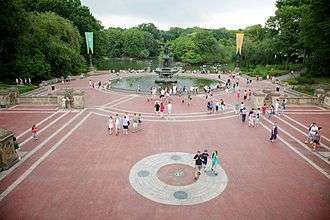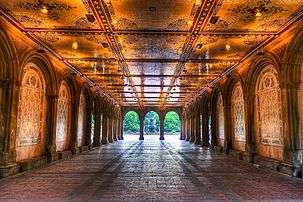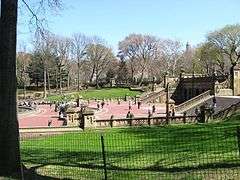Bethesda Terrace and Fountain
Coordinates: 40°46′27″N 73°58′16″W / 40.774123°N 73.971135°W

Bethesda Terrace and Fountain overlook The Lake in New York City's Central Park. The fountain is located in the center of the terrace.
Bethesda Terrace


Bethesda Terrace is on two levels, united by two grand staircases and a lesser one that passes under Terrace Drive to provide passage southward to the Elkan Naumburg bandshell and The Mall, of which this is the architectural culmination, the theatrical set-piece at the center of the park. The upper terrace flanks the 72nd Street Cross Drive and the lower terrace provides a podium for viewing the Lake. The mustard-olive colored carved stone is New Brunswick sandstone, with a harder stone for cappings, with granite steps and landings, and herringbone paving of Roman brick laid on edge.
Bethesda Terrace became a site for an outdoor luncheon restaurant at the end of the 1960s, then became a congregating spot for the Hair generation before devolving into a drug-trafficking venue in the 1970s. The fountain, which had been dry for decades, was restored in its initial campaign, 1980–81, by the Central Park Conservancy as the centerpiece of its plan to renovate Central Park.[1] The Terrace, designed by Vaux with sculptural decoration by Mould, was restored in the following season, its stonework disassembled, cleaned, deteriorated surfaces removed, restored and patched and reset.
Resodding, and fifty new trees, 3,500 shrubs and 3,000 ground cover plants specified by Philip Winslow followed in 1986,[2] most of which, having matured into dense blocks, were removed in 2008, to make way for plants native to the United States. The Minton encaustic tiles of the ceiling of the arcade between the flanking stairs, designed by Mould,[3] were removed in 1987, cleaned, restored, completed with additional new tiles and reinstalled in 2007.[4]
Following an illustration in an 1891 book by the Superintendent of Planting in Central Park, Calvert Vaux's assistant and partner, Samuel Parsons,[5] today in summer, the lower basin once again has water lilies, lotus and papyrus, grown in removable pots.
Bethesda Fountain


Bethesda Fountain is the central feature on the lower level of the terrace, constructed in 1859-64,[6] which is enclosed within two elliptical balustrades.[7]
The pool is centered by a fountain sculpture designed by Emma Stebbins in 1868 and unveiled in 1873.[8] Stebbins was the first woman to receive a public commission for a major work of art in New York City.[8] The bronze, eight-foot statue depicts a female winged angel touching down upon the top of the fountain, where water spouts and cascades into an upper basin and into the surrounding pool. It was the only statue in the park called for in the original design. Beneath her are four four-foot cherubs representing Temperance, Purity, Health, and Peace.[8] Also called the Angel of the Waters, the statue refers to the Gospel of John, Chapter 5 where there is a description of an angel blessing the Pool of Bethesda, giving it healing powers.[8] In Central Park the referent is the Croton Aqueduct opened in 1842, providing the city for the first time with a dependable supply of pure water: thus the angel carries a lily in one hand, representing purity, and with the other hand she blesses the water below.[8]
The base of the fountain was designed by the architect of all the original built features of Central Park, Calvert Vaux, with sculptural details, as usual, by Jacob Wrey Mould. In Calvert Vaux and Frederick Law Olmsted's 1858 Greensward Plan, the terrace at the end of the Mall overlooking the naturalistic landscape of the Lake was simply called The Water Terrace, but after the unveiling of the angel, its name was changed to Bethesda Terrace.
The panels of carving in the abstracted organic style propounded by Owen Jones, a mentor of the sculptor Jacob Wrey Mould[9] are organized by an iconographical program of themes: the Seasons, the Times of Day, the Ages of Mankind.[10] Considerable latitude was offered the carvers executing the work, following Ruskinian principles.
In popular culture


|
Video games:
Music and musical videos:
Literature:
|
Film:
TV:
|
See also
References
- ↑ Murphy and Ottavino 1986:24: "materials science, chemical testing, historical research, and attentive site supervision contributed to the successful rehabilitation of Bethesda Terrace".
- ↑ Central Park Conservancy on-line history Archived January 26, 2007, at the Wayback Machine..
- ↑ Clarence C. Cook, A Description of the New York Central Park, 1869, quoted in Murphy and Ottavino 1986:35.
- ↑ Murphy and Ottavino 1986 and Peter Champe and Mark Rabinowitz, "Restoring the Minton Tile Ceiling, Bethesda Terrace Arcade, Central Park, New York City" Association for Preservation Technology Bulletin, 30.2/3 (1999:11-16) described some of the difficulties surmounted in carrying out this project.
- ↑ Parsons, Landscape Gardening: Notes and Suggestions on Lawns and Lawn Planting...(1891), lithograph after a watercolor, page 253
- ↑ The concealed wrought-iron box-girder structure of the bridge, which forms part of the park drives' essential circulation pattern, was finished early, by 1860 (Murphy and Ottavino 1986:35).
- ↑ Jean Parker Murphy and Kate Burns Ottavino, "The Rehabilitation of Bethesda Terrace: The Terrace Bridge and Landscape, Central Park, New York", Bulletin of the Association for Preservation Technology 18.3 (1986:24-39)
- 1 2 3 4 5 6 "Ask Professor Ginkgo: The Fountains of New York". The Daily Plant. XVII (3695). New York City Department of Parks and Recreation. September 10, 2002. Retrieved January 3, 2015.
...the Angel of the Waters fountain (or Bethesda Fountain, as it's commonly called), was built in celebration of the completed 1842 Croton Aqueduct which delivered fresh water from Westchester throughout the city.... The fountain was created by sculptor Emma Stebbins (1815–1882), who was the first woman to be awarded the commission for a major public work in New York City. Although the fountain was not dedicated until 1873, Stebbins began work on the statue in Rome in 1861 (at the start of the Civil War) and she completed it in 1868. The brochure at the opening quoted a verse from the Gospel of St. John 5:2–4 that read, 'Now there is at Jerusalem by the sheep market a pool, which is called "Bethesda" whoever then first after the troubling of the waters stepped in was made whole of whatsoever disease he had.' Indeed, the Croton Aqueduct brought potable drinking water to the city and helped bring an end to many diseases that had plagued the city for years. The lily in the angel's hand represents purity, and the four figures below her signify Peace, Health, Purity, and Temperance.
I believe your confusion has arisen from a comment made by the playwright Tony Kushner in Ric Burn's [sic] New York: A Documentary Film. I have been told that Mr. Kushner incorrectly suggested this alternate explanation [that the fountain was Olmsted's tribute to the Union dead from the Civil War] of the Angel. - ↑ Murphy and Ottavino 1986:26.
- ↑ Commissioners of the Central Park Reports (New-York Historical Society), noted in Murphy and Ottavino 1986:26.
External links
| Wikimedia Commons has media related to Bethesda Terrace and Fountain. |
- Angel of the Waters Fountain at Central Park's Official Website
- The Bethesda Terrace and Fountain at CentralPark.com the Complete Guide to Central Park
- Bethesda Fountain at On The Inside